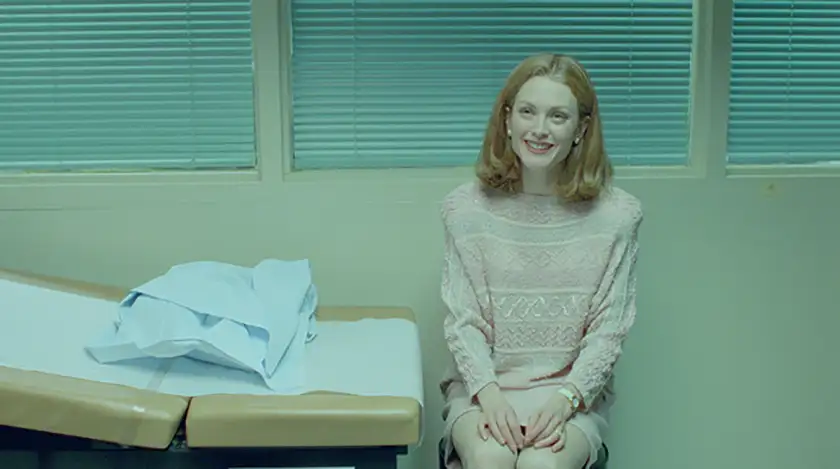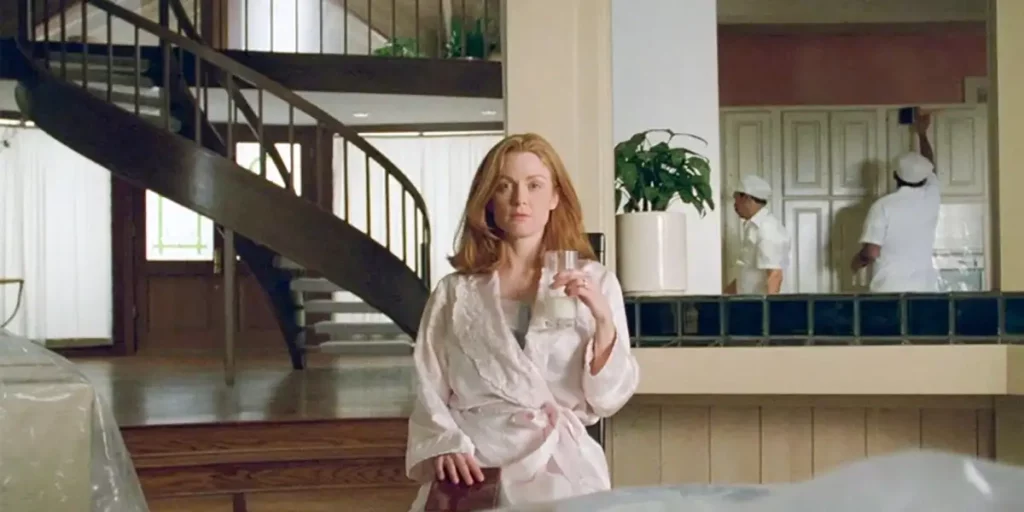Todd Haynes’ Safe, led by a brilliant Julianne Moore, utilizes ambiguity and things left unsaid to become one of the most terrifying movies of the 1990s.
A good opening shot can tell you the entire movie. Safe opens with a car traveling down the street of an affluent Southern California neighborhood. Dusk is falling and the indigo blue of the sky has an alien quality, like Dave traveling through the stargate at the end of 2001: A Space Odyssey. Around the corners of the frame we see status symbols – BMWs, large homes and uniformly well-maintained lawns. The camera glides along with the car as it pulls into the driveway of a tract house, an iron gate shutting behind it, sealing us off from the outside world with a thud. The music that underscores this all is an eerie minor key drone.
The filmmaker Todd Haynes fills every frame of Safe with the atmosphere of the uncanny, taking mundane, everyday things and twisting them ever so slightly to the left so that the viewer’s brain can process that something is off, but cannot articulate exactly what. The opening shot that I described earlier is coated with a feeling of dread and unease, but it would be near impossible to say exactly what you are afraid of happening.
The ambiguity of Safe has led to many readings: an environmental manifesto, a feminist treatise, an AIDS allegory. There are no answers in the movie, only hints, insinuations and possibilities. Rather than alienating the audience, the haziness is gripping, and makes for a haunting viewing experience. Safe is a horror movie. Just as in Jaws it is more frightening to imagine where the shark is lurking underneath the water, in Safe the possibilities of Carol White’s ailment are more terrifying than any answers a screenwriter could provide.
It’s 1987, and housewife Carol White (Julianne Moore) lives in the Southern California suburbs with her husband (Xander Berkeley) and stepson. Life is tranquil and quiet, filled with commutes, exercise classes, hair salon appointments, gardening and directions to the maid. The White’s tract house is pristine, with high white walls that make it look like a mausoleum.
Moore plays Carol as still a little girl, “a total milkaholic,” clothed in light pastel colors, and speaking in a thin, nasally Valley girl voice, with a sheepish way of holding her body, as though she was trying to take up as little space as possible. There’s no sense of interiority to Carol, no hint that she has taken up gardening or attends exercise classes because it is something that she enjoys. Like a Nora or a Jeanne Dielman, that is the routine that she must unthinkingly follow. Carol is not putting on a performance as a middle-class housewife because there’s no purpose behind it, no identity that she’s hiding. The turn into a Stepford wife happened so long ago that there is no before for Carol.

One day, while running errands, Carol is caught in her car behind a large truck blowing exhaust fumes right into her face. At the same time, her radio is turned to Christian fundamentalists discussing the inevitable end of the world. Carol’s throat seizes up and she begins to uncontrollably cough and wheeze.
Carol’s medical problems do not begin and end there. The cough is persistent, and she develops a laundry list of allergies. She vomits when her husband tries to kiss her goodbye. She collapses on the floor of a dry cleaners in a convulsion. None of the doctors, allergists and psychiatrists are able to provide any answers, reassuring Carol that she’s perfectly healthy and coming very close to diagnosing her with female hysteria. Her husband isn’t very much help either.
Passing by the bulletin board at the local health club, Carol spots an advertisement for a support group for sufferers from environmental illness. It has the attention grabbing line, “Are you allergic to the 20th Century?”. Carol begins to attend meetings. From the group Carol learns of Wrenwood, a wellness center in the New Mexico desert.
Wrenwood may or may not be a cult. It’s a hippy-dippy place that preaches self-love, but places blame for the disease on the individual, and creates an environment where highly vulnerable people feed off eachother’s neuroses.
Carol does not get better. In fact, she get worse, slowly retreating deeper and deeper into herself until she’s living in a hermetic igloo-type building. Carol has traded in one prison for another. In an interview with Bomb Magazine, Haynes said, “Safe is on the side of the disease, and not the cure. It’s the disease that completely opened Carol’s eyes and makes her rethink her life, and the cure that returns her to this sealed-off existence.”
One of the masterstrokes of Safe is how little it’s interested in what is actually wrong with Carol. It could be anything. What is important to Safe is how Carol psychologically reacts to her illness and how the world responds in turn. Through her illness, Carol finally gains some semblance of an identity, but that success proves short-lived. The meticulously framed long shots and mechanical sound design, wall-to-wall with electrical buzzes and hums, convey an environment set to swallow Carol whole.
Safe is a movie that creeps. It finds just as much in what is left unsaid as in what is articulated. Moments are all the more shocking for the deadpan note in which they are played. Carol’s sudden nose bleed at the salon is punctuated by the hairdresser with an “anyway, so…” At Wrenwood, the spectral presence of Lester is brushed off quickly but haunts the imagination of the audience for long afterward. Ironically, the distance at which Haynes keeps the audience makes the movie all the more involving. It forces you to fill in the space. Safe is one of the scariest movies of the 1990s, not through gore and jumpscares, but because of its very ideas.
Safe is now available to watch on digital and on demand.
Loud and Clear Reviews has an affiliate partnership with Apple, so we receive a share of the revenue from your purchase or streaming of the films when you click on the button on this page. This won’t affect how much you pay for them and helps us keep the site free for everyone.

